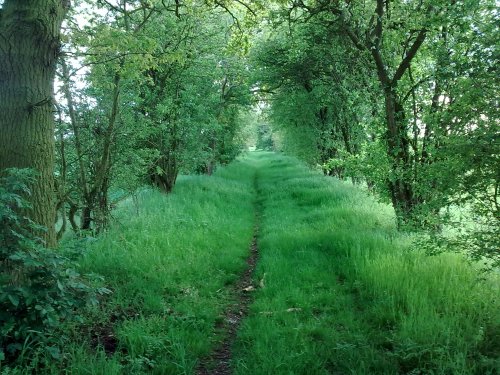May 19th, 2010. Evening. After a cold snap since the beginning of the month the weather has warmed over the last few days, with some fine sunny spells. Today is mostly overcast, but I can at last walk out in the evening without jersey or fleece. I follow a route I’ve taken many times before, up the B-road towards Cottenham, branching southwards along the medieval trackway here called Gunn’s Lane, then through the meadows and woods of Abbey Farm at Histon and back along tiny Histon Brook to Oakington.
It’s a fine walk, with the countryside at its freshest and greenest and densest. Spring at its height, just before summer sets in. The season of green, in every hue and depth and texture. All trees in leaf at last, though some oaks and others are only just so. Foliage is still whole and pristine, unblemished yet by insects, disease or decay. Hedgerows are dense, unseethroughable, paths and watercourses encroached, vistas curtailed and horizons lie just round the corner… the world’s close at hand. Short-cuts I used before, or field gaps I slipped through, are now overgrown with nettles. Few birds are to be seen though the hedgerows and coppices are full of alarm calls and cadences, most of which I cannot identify because I can’t see the singers. Birds have a trick of throwing their voices. Your ears pinpoint the source of a song in a tree or bush but you will search in vain for the bird, which is invariably some feet away, sometimes in a different place altogether. Anyone who has sought out birds will will have been frustrated and puzzled by this cunning display of ventriloquy.
I meet Mrs. Botanical, with whom I cross paths now and then. Local girl, who’s walked this district since childhood, noticing nature. A real naturalist. It turns out she is the daughter of the wild-gardening couple who were so welcoming on one of my earlier walks. I should have known… of course. They have infused in her their wonder of the wild. A very precious gift this, from parent to child, it seems to me…. better by far than a trust fund. She tells me of her own recent encounters – just this last week, in the little brook/ditch that runs from Histon to join our Beck Brook at the coppice, she has come across water voles, then the largest grass snake she’s ever seen, then some eels. She is so thrilled that it’s as good as seeing these creatures with my very own eyes. And it confirms my earlier sightings of grass snake and eel. The presence of the fast-declining water vole here is an unexpected surprise. Even though I regularly scan the banks of our various watercourses I have never even seen their tell-tale holes, just above the waterline.
Hawthorn blossom, though still not fully out everywhere, adorns the hedges and banks and woodland edges …. in fact the whole green countryside, wherever you look, is splashed with white. It reveals itself as the dominant hedge tree round here by far, with blackthorn less common. When hawthorn grows naturally, without hacking and topping, it throws out long arched sprays of blossom, with flowers all the way down to the tips. The red hawthorn seems later and is just breaking bud. Horse-chestnuts still in flower, lit with great, upright pinkish-white cones, evenly spaced over each tree. But the season really belongs to the wild flowers and flowering grasses, which are now in a rush, coming too many and too fast for me to identify. Sometimes their foliage is more interesting than their flowers. Lacy white cow-parsley, up to four feet high, is dominant now, along with the feathering grasses and uncoiling thistles. Big ox-eye daisies or moon daisies, two inches across with gold eyes, each one on a tall slender stem, have come up in the disturbed ground along the guided-busway. They are the loveliest of flowers and I want to gather them up and take them home, they’re that sort of flower. But of course there are too few about to pick even one, they might even be endangered, and it’s probably illegal.
At the ancient Abbey Farm, adjacent to Histon church, are retained some small pieces of old woodland, meadow, and an overgrown scrubby tract – some of the few places in the neighbourhood that are a little bit wild, or not overly managed at least. Sauntering some 50 yards in front of me, on a footpath winding through the latter, is a muntjac. Yes, it’s just the sort of place I would expect to see one, with plenty of open grazing close to cover. It trots like a dog, and curls its broad tail upwards, flashing the flat white underside like a banner. It disappears into a thicket. I emerge onto a broad sloping meadow, ungrazed and uncut, full of flowers, especially the buttercup. I’ve never seen so many buttercups – a field of buttercups. Not good for grazing stock perhaps, but perfectly harmless when cut and dried in the process of hay-making. I walk back along Histon Brook, with the setting sun in my eyes, looking for water voles. But nothing disturbs the water, which lies black and still and silent.






